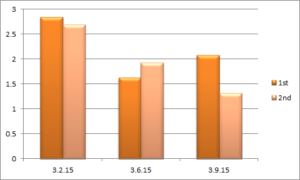HRV Monitoring Protocol: Clinical Case Study Migraine
Kristen Sparrow • March 10, 2015


Goddess of Compassion
“She who hears the cries of the world”
(This is probably too technical for general interest, but for any other researchers out there, maybe of interest.)
I seem to have reached an impasse in the research. What I’m looking for is a shorthand method of using heart rate variability monitoring (HRV) or stress monitoring in conjunction with acupuncture treatment in the clinic. The purpose is to help guide treatment and make it more effective. There are certain patients who have had dramatic results within a few visits, and I go back to their data again and again and again to see if I can capture the “shift” or any HRV indication of the clinical results they experienced.
My protocol has evolved in what time frame is the most sensitive. Unfortunately, with so many variables between patients, it’s been difficult. This is all speculative work, so I’m not sure what exactly I’m looking for. But the reduction in LF/HF continues to be the most significant change, though I keep looking at other parameters (LF norm, DFAα1, sampen, etc..)
Assumptions. 1) LF/HF decrease during treatment correlates most closely with clinical response
2) Since there is a fractal nature to many physiological processes, a decrease in LF/HF during treatment may indicate a decrease over time.
3) Point prescriptions are the basis of acupuncture training and treatment, so should result in different results clinically and in HRV.
So far, I haven’t been able to prove any of the above. So why haven’t I given up? Because there is such consistency within the data of a single patient. HRV is almost like a fingerprint. I can tell in a fraction of a second if I’ve pulled up the wrong patient’s data. So besides dumb stubbornness, there are too many interesting aspects. The following is one.
This data is from a new 62 year old patient who is in an extremely high stress, high responsibility, high profile position. He is suffering from anxiety, sleep disturbance and lifelong migraines. But he is healthy, slender, and physically fit. So according to my protocol comparing the first 5 minutes to the second 5 minutes his data look like this.
 So not too dramatic. In the second visit, he even had an increase in his stress response. So maybe positive, hard to know. But look at the next data set…
So not too dramatic. In the second visit, he even had an increase in his stress response. So maybe positive, hard to know. But look at the next data set…

What this represents is his stress level during the 5 min of needling and the 5 minutes immediately following. Now THAT is dramatic. Look at the magnitude of the shift. Almost 5 fold in the latter two visits. So far he has had measurable results. Anxiety during the night is gone. Fewer migraines. Not gone yet.
So is what we are seeing a receptiveness to physical intervention? A response to the “tap of the web” that acupuncture represents?
So far it’s very interesting but not conclusive in anyway.

